Related Content
Content
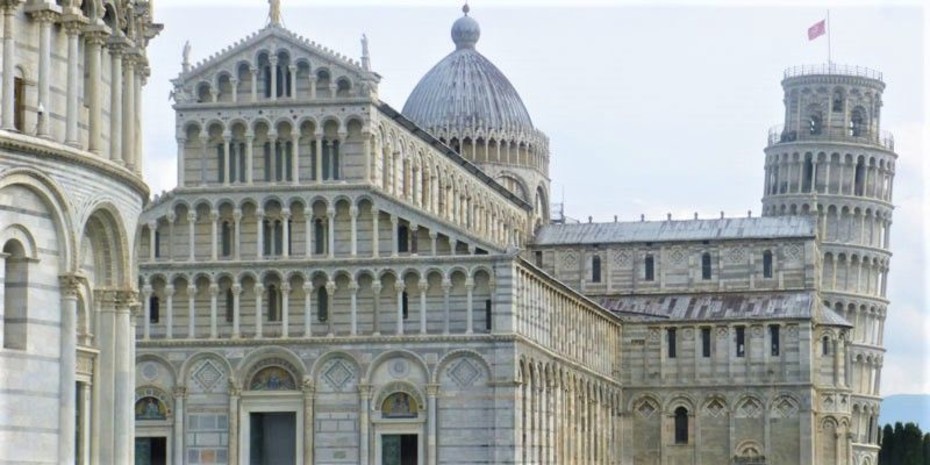
Episode 15: How to see the leaning tower of Pisa for five sweet minutes
Taking a journey from Verona to the south of France the long-way round through Florence, Pisa and Genoa isn't a great idea, but my travels enabled me to learn a lot about riding Italian trains.
Share
Travel in three or more European countries by train and what soon becomes fairly obvious is that each operator of the trains, whether it’s a government agency, or a private company, can set its own rules for how rail passes can be used.
This particularly impacts on reserving seats on the trains when using a rail pass, because they can be mandatory, optional or not available.
Also when reservations are mandatory for rail pass users, how they can be purchased locally isn’t universal.
Make a journey within France, Germany or Sweden and they can be booked on online alternatives to the Eurail/InterRail reservation services.
In Spain they have to be arranged at the advance travel desk in a station, in Belgium, Switzerland and The Netherlands they can be paid for at stations, but booking fees will be payable.
But a positive of using rail passes in Italy is that Trenitalia’s ticket machines are the only ticket machines in Europe which sell mandatory rail pass reservations.
So there’s no need to fret about purchasing a reservation for a journey on a route with frequent high speed Frecce trains, before you arrive in Italy
Though doing so just before your train will be leaving is best avoided for two reasons;
- the queues for the Trenitalia ticket machines will be shorter than at the ticket desks, but you can still be waiting in line for 20 minutes or more.
- the second reason is that it’s not unknown for some Frecce departures, particularly on the less popular routes, to sell out completely in advance.
So I tend to book any required reservations for a day of Italian train travel on the evening before departure. I can then confirm which train I’ll be taking, so will know when I’ll need to be at the station by; plus the time that would have been given over to purchasing the reservation, can then be dedicated to obtaining breakfast instead.
A tactic which paid off when I returned to Verona the prevous evening and discovered that my first choice of departure for the next day’s journey to Firenze/Florence had sold out.
Not a problem as I had a plan B prepared of taking the earlier train, which would also then allow time to stop over and see the Leaning Tower in Pisa later in the day.
Having a Plan B, or C in mind is always a good idea when embarking on more complicated European railway journeys.
On the train to Firenze
What can be a fascinating aspect of travelling around Europe by train is the insights that can be gleaned into national characteristics.
A trait which Italians seemingly share with British travellers is an eagerness to get a train journey over with as quickly as possible.
Up to 15 minutes before a train will reach its final destination, some Italian travellers inevitably typically begin to gather their belongings and head for the doors, which then causes a chain reaction; therefore long before the train arrives at the station, a queue will begin to snake through the train.
But unless you have a tightly timed connection into an onward train, it can pay off to remain in your seat(s) until the last minute before arrival, because if you leave it too early, you could then be on your feet for some time.
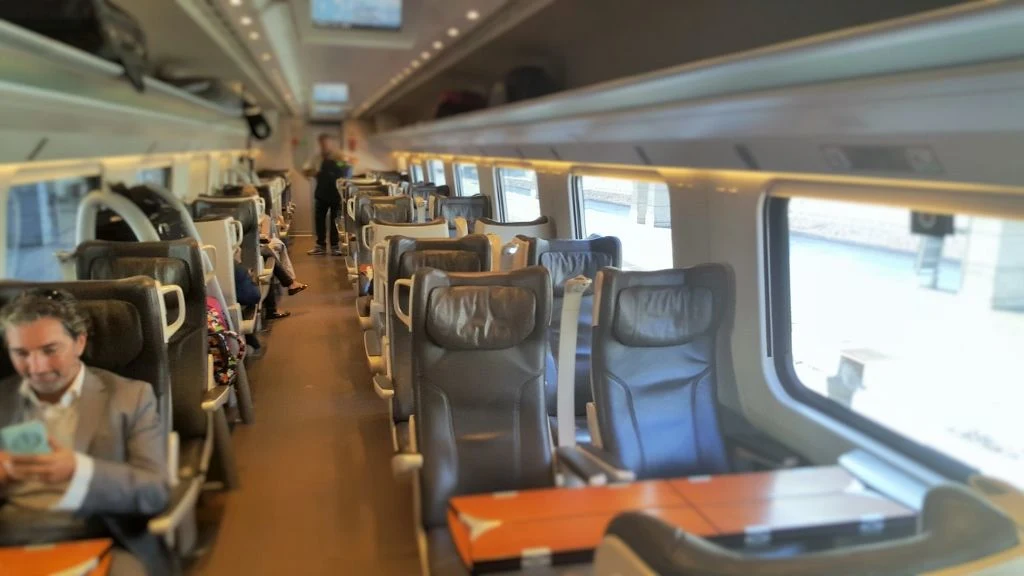
The high speed trains in Italy aren’t exceptionally punctual, of my 19 most recent journeys that I’ve taken by them, the train has arrived more than 30 mins late on five occasions.
I suspect that Firenze S.M.Novella station is the cause of many delays, it’s located closer to the heart of the city than any other major Italian station, so inevitably it’s a people magnet, but the trains travelling between Bologna and Roma have to divert off the direct route to access it.
It is also a terminus station, which is superbly convenient for travellers, but a pain for the heroes whose role in life is compiling train timetables, because the trains passing through Firenze S.M.Novella have to reverse direction.
Though that isn’t an uncommon scenario in Italy, those who feel more comfortable facing forwards when travelling on a train, should be aware that if you’ll be on a train passing through Milano Centrale, Roma Termini or Napoli Centrale, this switch of direction will also occur.
The train pulled into Firenze S.M.Novella 15 minutes late, so I had to run to make the connection into the train on to Pisa, but what I should have done is paused and remembered that taking time out to photograph S.M.Novella’s stunning architecture is why I was there.
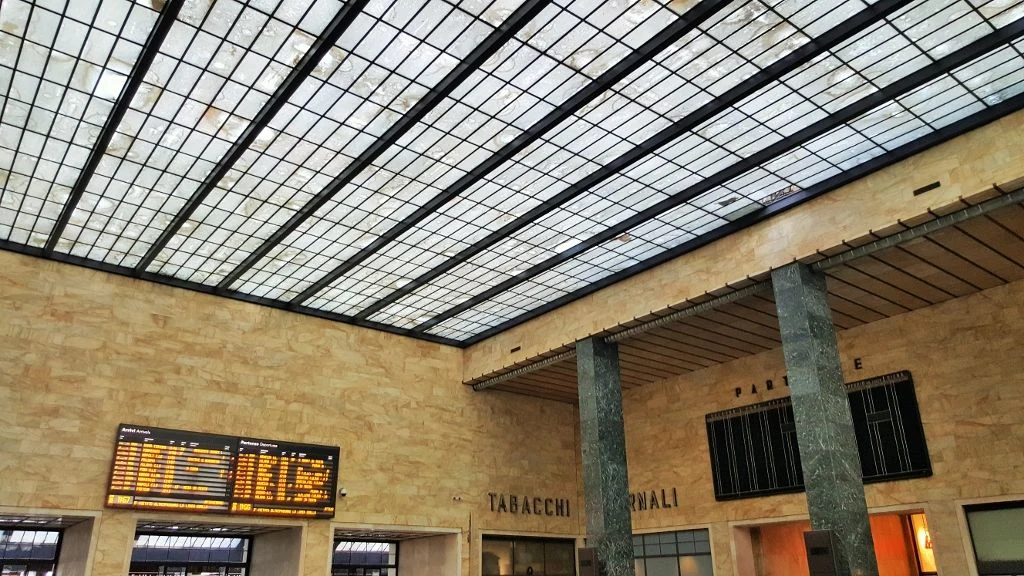
On to Pisa
Taking 30 seconds to have another look at the departure board would also probably have revealed that I didn’t have to run for the train at all, because the trains on the Firenze ↔ Pisa route are particularly frequent by Italian standards, with usually two, but sometimes three departures in an hour.
When I arrived panting and sweating at the train door I assumed a fellow traveller had taken pity on me by offering to heave my suitcase on to the train, but it was a scam.
As soon as I’d clambered on board, a hand was offered in which I was aggressively asked to deposit €2.
Though this may be a fairly rare occurrence, I’ve been on the lookout for this when making subsequent journeys from Firenze and haven’t seen any sign of it.
Something worth knowing when travelling in Italy by train is the difference between Regionale and Regionale Veloce (RV) services, because the RV services skip more stations on the routes they take, so they will get you to a destination faster, despite tickets being the same price as the Regionale trains.
Savvy Italian travellers know this, so RV services tend to be busy in any case, but late on Saturday mornings is rush-hour on the Firenze ↔ Pisa route.
For the time being Trenitalia tends to use trains which date back to the 1980s on its RV services, presumably to create a selling point for paying more for taking a Frecce train, when both services share a route.

One characteristic of these older trains is that the difference between 1st and 2nd class can be negligible, so paying the higher price for a 1st class ticket can seem pointless, so it’s inevitably less popular.
But despite boarding at the last minute I’d managed to bag one of the few remaining seats in 1st class, but 2nd class was packed with standing passengers; and this is why 1st class can be worth a few extra euros.
I am rather partial to travelling on these older Italian trains with their chatty atmosphere, as they rattle down the tracks.
There are signs above the windows which in effect say ‘please don’t open the windows, because if you do the air-conditioning won’t work’, but it never seems to in any case, so in summer every window is open.
And fresh air breezing through a train is becoming a rare phenomenon on the European rail network, with sealed air-conditioned becoming a standard feature on trains rolling off the production lines.
But what I love the most on these Regionale/RV trains are the on-board announcements
Trenitalia makes more effort than many European train operators, to provide bilingual information, no matter which train or station you will be using.
Though what understandably gets ignored is the ‘English’ names of Italian cities and towns, as Italians aren't understandably not interested in this somewhat bizarre presumption.
During this journey I wondered how this somewhat bizarre multi-naming conventions for cities had ever come to be:
What do you call this fair city?
Torino, my lord.
Sorry what was that, To-ri-no? Doesn’t sound like English to me.
Well er no, but we Italians think it sounds rather lovely.
No that won’t do it all, we’ll call this place Turin.
What is the meaning of Turin?
Oh nothing at all, it isn’t an English word, but sounds rather Italian don’t you think?
So when travelling on an Italian train, the English version of the on board announcements follow the Italian, but the part of the recording which lists the station calls is repeated in Italian.
Hence announcements along these lines; “This is the 10:28 train to Laspeziacentrale which will call at Firenzerifredi empoli sanminuetofuecchio pisacentrale pisasanrossore…”
Risking a last minute decision
A lesson that I was learning the hard way on this trip was not to take a chance.
While undertaking my more recent adventures I’ll exploit the hotel wifi to look up the finer details of my next day’s travels, to work out plan Bs and Cs in case the original idea doesn’t work out.
But on this occasion my off-the-cuff plan for Pisa was to use the 90 minutes before my train on to Genova departed, to at least see the tower, with the first step being to leave the suitcase in Pisa Centrale’s left luggage facility.
But this idea was thwarted, the left luggage offices at Italian stations are staffed, they don’t have lockers, so you need to your have bags processed by the attendant and at Pisa Centrale station on a Saturday lunch time, more than 20 people were waiting in line.
Seeing the tower between train departures is obviously not a particularly original idea.
So the choice was to drag my case to the tower or wait it out at Pisa Centrale, which aside from a snack bar which sells rather good slices of pizza, has little else to recommend it.
However, the tower is some distance from Pisa Centrale, therefore trailing my suitcase through the streets for 20 minutes or more was a non-starter.
The bus stop in front of the station was devoid of any info as to what routes called there and when, but I remembered that Seat 61 has a great tip about a different station in Pisa being a stone’s throw from the tower.
In the days before the reductions in data roaming charges, the best option for confirming this info was to head into the Tourist Office in the station.
I waited in line behind a string of people who all asked how to get to the tower and were all told to take a bus, but when I asked about the station near the tower, the guide beamed with delight and rapturously informed me that I needed to travel to Pisa S. Rossore station.
A train to it was leaving in five minutes, but would I be able to get back to Pisa Centrale in time? Because I now had only 70 minutes to spare for my little adventure.
On arrival at San Rossore station I consulted the train departure poster, in a worst case scenario I’d have to head straight back to Pisa Centrale, but I had 25 mins, so only enough time for a quick look, but better than nothing.
In the staircase at the station a thoughtful station employee had drawn a picture of the tower and added an arrow.
I had the streets outside the station to myself, so the plan to harras a local by saying "Tower" and pointing, was foiled.
On reaching the main road I had a choice of left or right, but to the left was a garage which would sell me a cold drink and be staffed by someone who could hopefully point me in the right direction, but this garage was actually right across the street from the rear entrance to the cathedral grounds, which house the tower.
Victory was mine!
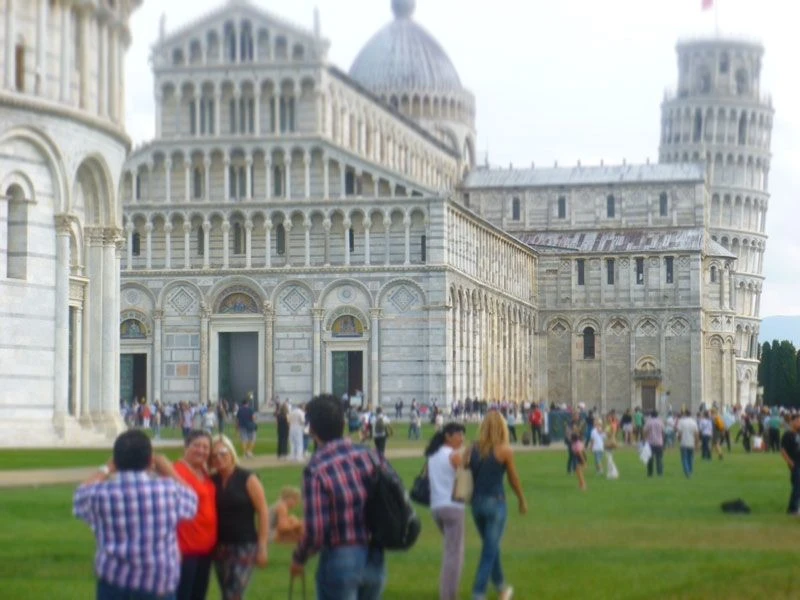
My sense of jubilation soon evaporated, on returning to San Rossore, becasue I couldn’t see the train I planned to take back to Pisa Centrale on the departure monitors,.
I gradually realised I’d made an error, which I now know how not to repeat.
The departure posters at Italian stations aren’t separated into different days of the week, despite different timetables applying on Saturdays and Sundays, so all the departures are listed in consecutive order.
Notes, which are only available in Italian, appear under the details of the station calls, and convey highly significant info such as ‘does not depart on Saturdays’, but in my haste to hot foot it to the tower, I’d ignored this info.
The plan B train was running late, but fortune favoured the brave, because the delayed arrival of this train in Pisa Centrale, evidently also held up the InterCity train to Genova, so it was still awaiting departure, just across the platform from where the train from San Rossore pulled in – hurrah!
These days I’d have exploited data roaming to look up the times of all these trains on the Trenitalia app or website before I’d even arrived in Pisa, but when you can’t get online or don’t want to have your phone in your hand at major Italian stations, those train departure posters can be a treasure trove of information.
On to France:
I needed to be on that train to Genova, because despite the time being around 16:00 by now, I was heading on to France.
My sense of elation at having boarded the InterCity train with seconds to spare was fleeting, as I now found myself in the midst of a bizarre scenario which I hadn't encountered on a train before, or since.
Some of the coaches on Italian InterCity trains have seating bays served by a side corridor.
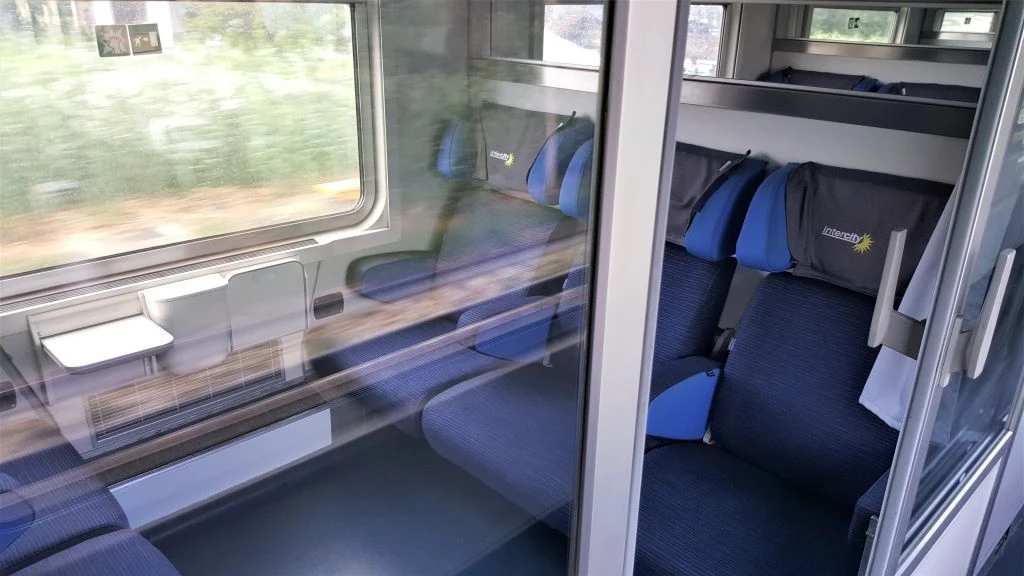
It was a Sunday evening and there were almost as many suitcases in the carriage on the train as passengers, something which I couldn't help notice because many of them were literally piled up in this side corridor.
The issue being is that these coaches with compartments don't have the type of luggage racks which are fixed to the floor, so the only suitcase storage space is on the shelves above the seats.
The compartments can sit six people, but these shelves can only accommodate around four medium sized bags, so you don't need to be a maths genius to work out the chances of there not being enough luggage space for everyone.
Not helped by the fact that some travellers had assessed the effort required to get a suitcase up above their heads and decided against it.
But now these plethora of cases in the corridor were proving to be a barrier to my access to the available seats.
I lacked the Italian to ask my fellow travellers if the bags I was now having to heave my own suitcases over belonged to anyone in particular, so had to perform the sort of manoeuvres encountered on an army assault course.
So yet another top tip I'm passing on, is that when planning an InterRail itinerary, try to avoid travelling long-distances at times when trains will likely be at their busiest; Friday and Sunday late afternoons and evenings and summer Saturday mornings are best dodged if possible.
My efforts to dump myself in a seat were a tad superfluous, because less than 30mins later, I was on my feet in the train corridor.
Not because I'd had to give up my seat to a fellow traveller, which is always something of a risk factor when not opting to reserve when using a rail pass on Trenitalia's InterCity trains, but because the corridor was a now a window onto one of Europe's most spectacular coastal railway journeys.
This journey plays a fabulous trick on travellers, because after departure from La Spezia Centrale station the train enters a long tunnel, but after a few minutes of darkness, the sea suddenly appears over on the right when heading north.
The tunnel has an equivalent of windows carved into it which are by the water's edge, and they provoked some of my fellow travellers to exclaim "Wow, did you see that?" And that doesn't happen on the 12:42 from Orpington.
Connecting in Ventimiglia
Having transferred between InterCity trains at Genova Piazza Principe station, I would now be taking my fifth and final train of the day, so that I could cross the border into France.
At Ventimiglia station I found myself part of a crowd of hundreds of people making the transfer from the Italian InterCity train into a local French TER train, heading on to Menton, Monte-Carlo, Nice, Antibes, Cannes and Grasse.
The only location in which I'd seen more people connecting from one train to another was at London Bridge station in the rush hour.
Within a few months of this adventure, a train service provided by Thello had woken up to the demand for travel by train between the Italian and French Rivieras and beyond and introduced the very welcome direct trains on a Milano - Genova - Albenga - Sanremo - Ventimiglia ↔ Menton - Monte-Carlo - Nice route.
Almost inevitably they proved to be popular and at the annual timetable change in December 2019 a daily Milano ↔ Marseille train was introduced which had the potential to transform travel by train between the south of France and the north of Italy.
Because it united the French and Italian Rivieras, it was also an instant addition to the list of Europe's most beautiful journeys by express train thanks to hour after hour of stunning coastal views.
But within four months of its launch, the collapse of international travel provoked by the pandemic led to the withdrawal of this train and the other Thello services, which have now since been cancelled permanently.
Despite the impact of the pandemic Europe's international rail services have proved to be resilient, but this loss of the Thello services hopefully won't prove to be long-term.
Without them up to a thousand people per day will once again be changing trains at Ventimiglia, which is bordering on the absurd!

Simon Harper
I wanted to share my passion for train travel and explain how anyone can take the fantastic journeys I have taken.

This is one of more than 100 train travel guides available on ShowMeTheJourney, which will make it easier to take the train journeys you want or need to make. As always, all images were captured on trips taken by ShowMeTheJourney.
This second version of ShowMeTheJourney is exciting and new, so we are genuinely thrilled that you are here and reading this, but we also need your help.
We’re striving not to let anything get in the way of providing the most useful service possible, hence a facility has been set up with DonorBox which can be used to support the running costs and make improvements.
Instead of advertising or paywalls, your financial support will make a positive difference to delivering an enhanced service, as there’s a lot of ideas which we want to make happen.
So if you have found the info provided here to be useful, please consider saying thank you.




